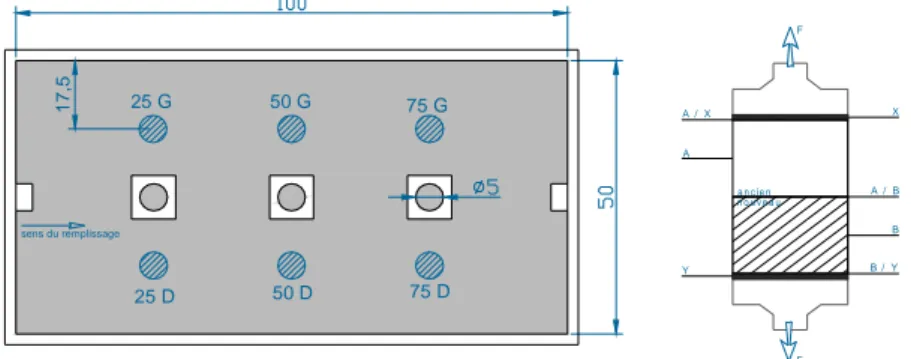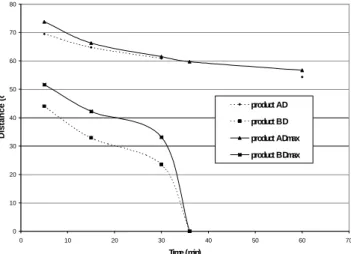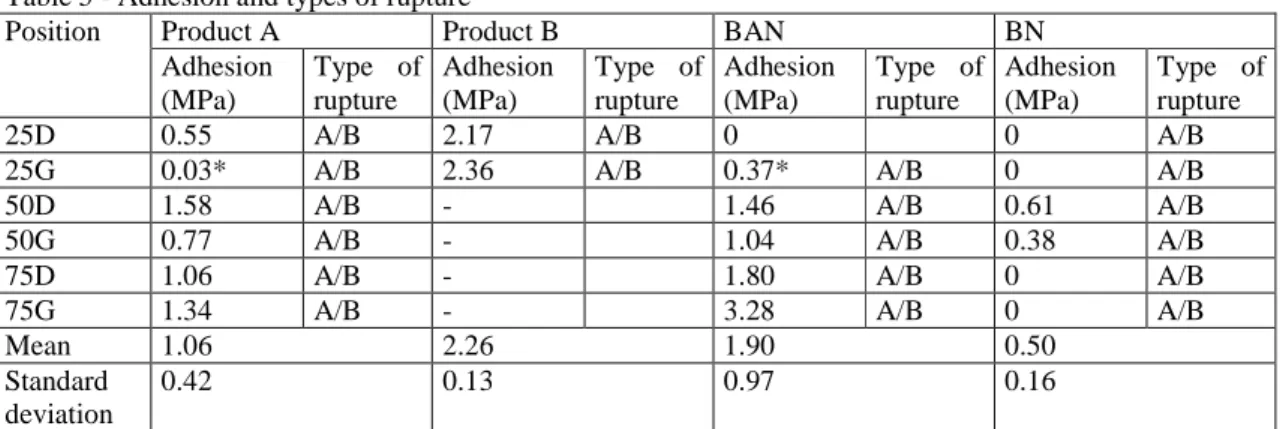REPAIRING CONCRETE WITH SELF COMPACTING
CONCRETE: TESTING METHODOLOGY ASSESSMENT
L. Courard, A. Darimont, X. Willem, C. Geers and R. Degeimbre
Department GeomaC, Research Unit on Building Materials, University of Liège, Belgium
INTRODUCTION
The quality of repair will depend on the properties of the two bodies to be bonded: mechanical interlocking, thermodynamic and electro-physical interactions are the mechanisms at the base of the interface creation and stability [1,2]. These last items require the repair material to be sufficiently low viscous so that it can be spread on the surface and penetrate into the capillaries of the superficial concrete layer [3]. This is why contact must happen as soon and as quickly as possible, as viscosity increases with time due to the setting process and evaporation of the liquid phase of the repair material. Balconies (Fig. 1) are particular concrete structures, sensitive to many potential degradation processes: water is the main vehicle for the intrusion of aggressive substances [4]. Moreover, it is also at the base of degradation due to freeze-thaw cycles or dissolution of minerals.
1. concrete slab
2. low strength concrete for slope 3. waterproofing membrane 4. sand stabilised with cement 5. ceramic tiles laid on mortar Fig 1. Typical balcony structure
Even if the upper surface is protected with a waterproofing layer, it is often necessary to repair the under face for aesthetic or structural reasons. Dry-mixture shotcrete and patch repairs are two classical methods that can be used for repairing these concrete elements. The first method can give high values of adhesion and limit shrinkage by using an adapted W/C ratio and admixtures: the main disadvantage of shotcrete in this case is dust and rebound, which are unacceptable for areas like housing and buildings. Patch repairing is very time- and labour- consuming. A comparison of costs [4] shows that Self-Compacting Concrete (SCC) can be an interesting option if it is possible to fix and reuse a mould under the structure [5].
SCC is a concrete that can be cast without any consolidation and is characterised by a good resistance to segregation. From a rheological point of view, its special design will induce a decrease of shear stress and a sufficient plastic viscosity [6].
The aim of this work is to compare the behaviour of ordinary and self-compacting concrete by means of a performance test that represents a situation where a thin layer of
5
repair material has to be applied on the under face of a balcony. Two other repair mortars have been applied in the same conditions to have an idea of the influence of granulometry and polymers. Adhesion is the main property that is analysed because it is an essential parameter for durability.
DESCRIPTION OF THE PRODUCTS
Two commercial mortars (A and B) and two concretes (BN and BAN) have been tested. Product A is a classical Cement Concrete, while product B can be classified as PCC (Polymer Cement Concrete). The main characteristics of the two products are given in Table 1. They are mortars classically dedicated for grouting.
Table 1. Characteristics of mortars A and B Property Mortar A Mortar B
Volume mass 2200 2143
Flexural strength (MPa) 6.63 12.16 Compression (MPa) 89.26 46.68 Tensile strength (MPa) 3.45 4.69 Water absorption (kg/m².h½) 0.8 0.2
BN concrete is a basic concrete designed according to Dreux-Gorisse in order to obtain a fluidity classification S4/F4 (slump greater than 150 mm and flow greater or equal to 210 mm). BAN is a Self-Compacting Concrete designed in accordance with the Okamura modified method [7,8]. Ouchi [7] has proposed a rational method for determining a satisfactory combination of water/powder ratio and superplasticizer dosage. Each parameter is determined independently, thus minimising the number of tests required (spread and V-funnel). The targets are C20/25 for resistance and W/C = 0.5 for durability, in accordance with EN 196. The value of W/C is imposed for moist environmental conditions with freeze and salts. Adaptation of quantities was necessary to fulfil the workability requirements and the final composition is given in Table 2.
Table 2 – Composition of ordinary and self-compacting concretes
Quantity (kg/m³) Composition Type
BN BAN
Aggregates Crushed limestone 2/7 860 698
Sand Crushed limestone 0/2 River sand 0/4
585 120
644 160
Cement CEM I 42.5 R HES 600 458
Filler Limestone CALCITEC 2001 MS - 190
Water City water 252 192
Superplasticizer VISCOCRETE 3200 1.5 % 1.5 % Viscosity agent SIKATELL 300 VP 0.3 % - HORIZONTAL TESTING PROCEDURE
This test program is organised for the particular situation in which the repair material is an SCC. Guidelines and standards have been developed in Belgium for classical hydraulic binder-based repair systems agreement, but it was necessary to adapt the tests and the prescription to Self-Compacting Concrete. The usual prescription for repair
mortars (G0007) are based on adhesion: > 1.8 MPa for non-structural and >2.4 MPa for structural repairs.
Repair product is flowed or pumped under a concrete slab in horizontal position (fig.2). Concrete slab (500 by 1000 mm) is prepared and sandblasted in accordance with prEN 17661. Three holes diameter 50 mm are cored on the medium axis at 250, 500 and 750 mm from the edge, respectively. These holes are closed with PMMA plates that are glued to concrete with silicon. Concrete slab is held in position and separated from formwork with wood pieces.
Fig. 2 – Position of the cores and type of rupture
Mortar or concrete is flowed through 30 x 50 mm hole from one extremity of the slab; the same hole on the other part of the slab is used as breather (fig.2). The final thickness of repair material is 30 mm. Formwork is made of polyethylene plates. Slabs are dried before application. Test conditions are 25±2°C and 50±5% R.H.
Formwork is removed after 48 h and the slabs are stored under environmental application conditions and at 20±2 °C for 7 days and 60±5 % R.H. for 21 more days. Visual observation of the surface of the new layer and of the slices obtained after sawing the slab in the two main directions are realised; evaluation of adhesion (minimum 6 specimens diameter 50 mm cored from the slabs (fig.6)) and resistance to bleeding (EN 445) are also investigated. Resistance to bleeding is evaluated by the measurement of the quantity of water that goes up to the top of the material (150 mm high) in a cylinder of 50 mm. Evaporation is avoided by means of a plastic film.
RESULTS AND DISCUSSION Applicability
The first observation concerns the effectiveness of the products to fulfil the volume between the concrete slab and the formwork. This appears to be neither evident nor easy (Table 3). Product B seems to present problems due to a too quick “setting”, which is shown by the results of the flow tough test (Table 4). The maximum distance attempted by product B is 47 cm; the shearing stress is probably too high for this material. One must also observe that the holes through the concrete substrates are not fulfilled completely, except for product A. Once again, this is a question of minimum
1 Concrete MC(0.45) corresponds to 395 kg/m³ cement content and W/C= 0.45.
25 G 50 G 75 G 25 D 50 D 75 D sens du remplissage 1 7 ,5 X A / X A B B / Y Y A / B F F a n c i e n n o u v e a u
requirements for shearing and viscosity as well as the evolution of these properties over time.
Table 3. Applicability test results
Product A Product B BAN BN Application method pumping flowing (funnel) pumping pumping Fulfilling completely Incompletely completely completely
25 cm completely Completely completely no Fulfilling of the holes 50 cm completely No no no 75 cm completely No no no
Other interesting information comes from observation of the slices. No visible segregation is observed at the interface. Air bubbles are however numerous, particularly for BAN and BN (fig. 3).
P ro d u ct A P ro d u ct B B A N B N
Fig. 3 – Concentration of air bubbles at the interface between concrete substrate and repair material
The products used with pumping seem to present a higher concentration of air bubbles, locally or all along the interface. The quantity of air bubbles is “average” for concretes and “low” for products A and B. More investigations are needed to quantify the phenomenon more precisely.
M [41 cm] F M [3 2 cm] J [19 cm] M f : 4 7 Very low (f) Low (F) Average (M) High (E) Contiguous (J)
Behaviour of fresh material
The two types of concrete have been designed to fulfil the usual requirements: for SCC in horizontal application, it is recommended to have a slump-flow of 800±50 mm and a Funnel-time of 7±2 s. The slump-flow is quite low for BAN, but not that far from the optimum values (Table 4).
Table 4 - Behaviour of fresh material
Test Product A Product B BAN BN
time (min) D (cm) Dmax (cm) D (cm) Dmax (cm) - -
5 min 69.5 73.8 44 51.7 - -
15 min 64.8 66.3 32.9 42.2 - - 30 min 60.9 61.5 23.5 33.2 - - Flow trough test
60 min 54.3 56.7 too viscous too viscous - -
Funnel time (s) 3 13 8 9
Slump-flow (mm) - - 720 760
The principle of the Flow Trough test (prEN 13395-2) is to measure the flow of a fixed quantity of the mortar (1 litre) along a defined trough after 30 s. The distance that the mortar has travelled in that time is the flow value. The maximum distance that is travelled is also registered. The flow is determined after 5, 15, 30 and 60 min.
As already noted, the behaviours of products A and B are completely different and can explain what happened during the applicability test. The decrease of flow is higher for product B and it is finally impossible to make the test after 60 min (Fig. 4).
Only BN offers a bleeding of 3%; none of the other materials present any measurable bleeding. The behaviour of BN is not very surprising, as it was already observed during the mixing operations.
0 10 20 30 40 50 60 70 80 0 10 20 30 40 50 60 70 Time (min) D is ta n c e ( c m ) product A D product B D product A Dmax product B Dmax
Fig. 4 – Evolution of D and Dmax at Flow tough test for products A and B Behaviour of composite
Adhesion doesn’t fulfil usual requirements (min. 1.8 MPa), except for product B that is a PCC mortar (Table 5). However, it was not able to flow correctly until the end of the formwork. For product A, the visual inspection of the interface showed the presence of
air bubbles until 41 cm: the specimens cored in this area (25 G and D) are characterised by a very low value of adhesion.
Table 5 - Adhesion and types of rupture
Product A Product B BAN BN
Position Adhesion (MPa) Type of rupture Adhesion (MPa) Type of rupture Adhesion (MPa) Type of rupture Adhesion (MPa) Type of rupture
25D 0.55 A/B 2.17 A/B 0 0 A/B
25G 0.03* A/B 2.36 A/B 0.37* A/B 0 A/B
50D 1.58 A/B - 1.46 A/B 0.61 A/B
50G 0.77 A/B - 1.04 A/B 0.38 A/B
75D 1.06 A/B - 1.80 A/B 0 A/B
75G 1.34 A/B - 3.28 A/B 0 A/B
Mean 1.06 2.26 1.90 0.50
Standard deviation
0.42 0.13 0.97 0.16
* the mean value of adhesion is calculated without taking into account this result.
For BAN, the same considerations can be mentioned: we observe an increase of adhesion values with the decrease of air bubbles concentration. If one doesn't consider the result of 75G, the mean value would be 1.44 MPa, which is lower than requirements. Finally, for BN, the high quantity of air bubbles and the contiguity between many of them can explain the very low value of adhesion.
CONCLUSIONS
The following conclusions may be reached from the present investigations concerning the behaviour of SCC used for repairing concrete:
• the use of polymer in cementitious material increases the quality of the interface in the case of dry substrate and induces an enhancement of adhesion;
• the adhesion of cementitious materials (product A, BAN and BN) could be improved by using saturated concrete substrate. The dry state of concrete slab indeed induces a migration of water from the fresh material to the concrete versus its porosity. Consequently, W/C ratio decreases and the layer of the new material at the interface is not as resistant as the bulk material: interface is a brittle zone;
• the applicability test provides interesting information on the effectiveness of the products to be used for the repair of under-structures. The difficulties we met during the applications are very instructive and clearly show that more research needs to be conducted to elaborate final products. The requirements established for the use of SCC in horizontal conditions are not sufficient to be sure that the product will be efficient in this case;
• it is not evident that any product could be used without pumping. It is of course possible to reduce the viscosity of the material to promote its progression between the formwork and the concrete; this could however induce in parallel an important segregation. The roughness of the substrate has a “negative” effect on this progression and the real surface preparation will surely induce a somewhat higher waviness and roughness: this means that the operation will again be more difficult.
A step forward in this research is the durability of the repair operation. It is necessary to investigate potential problems of shrinkage and creep versus loading rate and type of repair material. These concretes with high cement content may be sensitive to such phenomena.
REFERENCES
1. Courard, L. (2000). Parametric Study for the Creation of the Interface between Concrete and Repair Products. Materials and Structures 33, pp. 65-72.
2. Mindess, S. (1987). Bonding in Cementitious Composites: How important is it ?
In Bonding in Cementitious Composites. Edited by Mindess, Pittsburgh, pp. 3-10.
3. Courard, L. The role of the Interfacial Transition Zone in the adhesion of repair materials on concrete substrate. A.C.I. (sent for publication).
4. Geers, C. (2002). Use of self-compacting concrete in repair technique: application to balconies. Master degree final work, Faculty of Applied Sciences, University of Liège, 74p. (in French).
5. Lacombe P., Beaupré D. and Pouliot N. (1999). Rheology and bonding characteristics of self-leveling concrete as a repair material. Materials and Structures 32, pp 593-600.
6. Ambroise J. and Pera J. (2000). Effect of type of superplasticizer on loss of workability of Self-Levelling Concrete, Sixth Canmet/ACI International Conference on Superplasticizers and Other Chemical admixtures in Concrete, SP195-18, Nice, France, pp291-304.
7. Ouchy M. (1998). History of development and applications of Self-Compacting Concrete. International Workshop on SCC, 23-26 August, Japan.
8. Ladang C. (2001). Mix design on the base of fundamental parameters. In Zelfverdichtend beton, beton van de toekomst?, Ed. Concrete Belgian Group and Technologisch Instituut, Antwerp, 11p. (in Dutch).
STANDARDS
• EN 445. Grout for prestressing tendons – Test methods – Resistance to bleeding. European Committee for Standardization (1996).
• EN 1542. Products and systems for the protection and repair of concrete – Test methods – Measurement of bond strength by pull-off. European Committee for Standardization (2001).
• G0007. Belgian guidelines for the Technical Agreement of hydraulic-based repair mortars. UBATc’s Specialised Group “Repair and Protection of Concrete”, Ministry of Equipment and Transportation (1995).
• prEN 13395-2. Products and systems for the protection and repair of concrete – Test methods – Determination of workability – Part 2: Test for flow of grout or mortar. European Committee for Standardization (2001).




